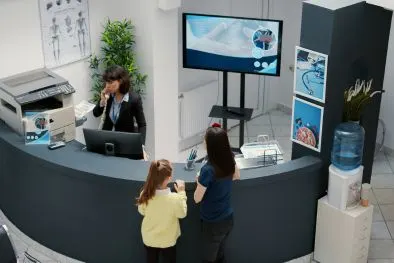Overview
A multi-specialty hospital network faced the need of significant updates in its appointment scheduling system, which relied on its on-premises legacy platform. The system's limitations to integrate with the broader infrastructure resulted in fragmented workflows, delayed access to care and high rates of patient no-shows. These inefficiencies not only compromised the patient experience but also led to suboptimal utilization of clinical resources and care delivery gaps. KodeFast initiated a comprehensive modernization initiative to streamline appointment scheduling, improve resource allocation and enhance the overall patient journey across ambulatory, diagnostic and specialty services.
Challenges
- Fragmented Scheduling Workflows
- High No-Show Rates
- Inefficient Resource Allocation
- Limited Patient Access
- Disjointed Integration with Clinical Systems

Fragmented Scheduling Workflows
- Patients experienced prolonged delays in securing appointments, particularly for specialists in cardiology, oncology and endocrinology
- Departments operated in silos, with no real-time visibility into clinician schedules, contributing to scheduling conflicts and resource underutilization

High No-Show Rates
- No-show rates exceeded 20%, disrupting clinical workflows and reducing care continuity
- The absence of automated appointment reminders and rescheduling options exacerbated patient non-compliance

Inefficient Resource Allocation
- Lack of predictive analytics hindered optimization of outpatient clinic schedules, operating room block times and radiology services
- Inefficient use of resources led to both under-booked and over-booked time slots, impacting throughput and revenue

Limited Patient Access
- Patients faced barriers in accessing appointments due to limited operating hours for scheduling services
- Complex workflows and poor user experience of the legacy system disproportionately affected elderly patients and those with limited health literacy

Disjointed Integration with Clinical Systems
- The scheduling system was not interoperable with diagnostic and therapeutic services, such as laboratory and imaging departments, leading to delays in pre-visit readiness
- Follow-up care planning was manual and error-prone, with missed referrals and delays in specialist consultations
Solution Approach
-
Deployment of smart Scheduling Platform
-
Implementation of Automated Appointment Management Tools
-
Optimization of Resource Utilization
-
Integration with the EHR and Clinical Systems
-
Enhancing Patient-Centric Access
Results
Reduced No-Show Rates
- Automated reminders, coupled with real-time rescheduling options, decreased no-show rates by 30%.
- Follow-up surveys indicated that 90% of patients found reminders and self-service rescheduling improved their compliance with scheduled visits
Enhanced Operational Efficiency
- Predictive analytics optimized resource utilization, improving outpatient clinic efficiency by 25% and reducing clinician idle time by 15%.
- The coordinated scheduling of diagnostic services (e.g., MRI, CT, and laboratory tests) minimized delays in diagnostic workups and expedited treatment planning
Improved Access to Care
- Patients reported a 40% improvement in their ability to secure timely appointments, with the average wait time for specialist consultations reduced by 50%.
- Self-service scheduling accounted for 70% of all new appointments, empowering patients to take an active role in managing their care
Streamlined Care Coordination
- Integration with the EHR facilitated seamless transitions of care, with automated referrals ensuring timely access to specialists and ancillary services.
- Care teams reported a 20% reduction in administrative tasks, allowing clinicians to focus more on patient care
Enhanced Patient Satisfaction
- Patient satisfaction scores improved by 50%, with high ratings for ease of use, flexibility, and accessibility of the scheduling platform.
- Patients particularly appreciated the ability to coordinate multiple services (e.g., specialist visits and diagnostic tests) within a single day, reducing the burden of multiple visits
Conclusion
By modernizing its legacy appointment scheduling system, the hospital network achieved a transformative improvement in operational efficiency, care coordination, and patient engagement. The adoption of AI-driven scheduling tools, interoperability standards, and patient-centered design principles ensured a seamless experience for both patients and providers, addressing critical gaps in care delivery and resource management.


